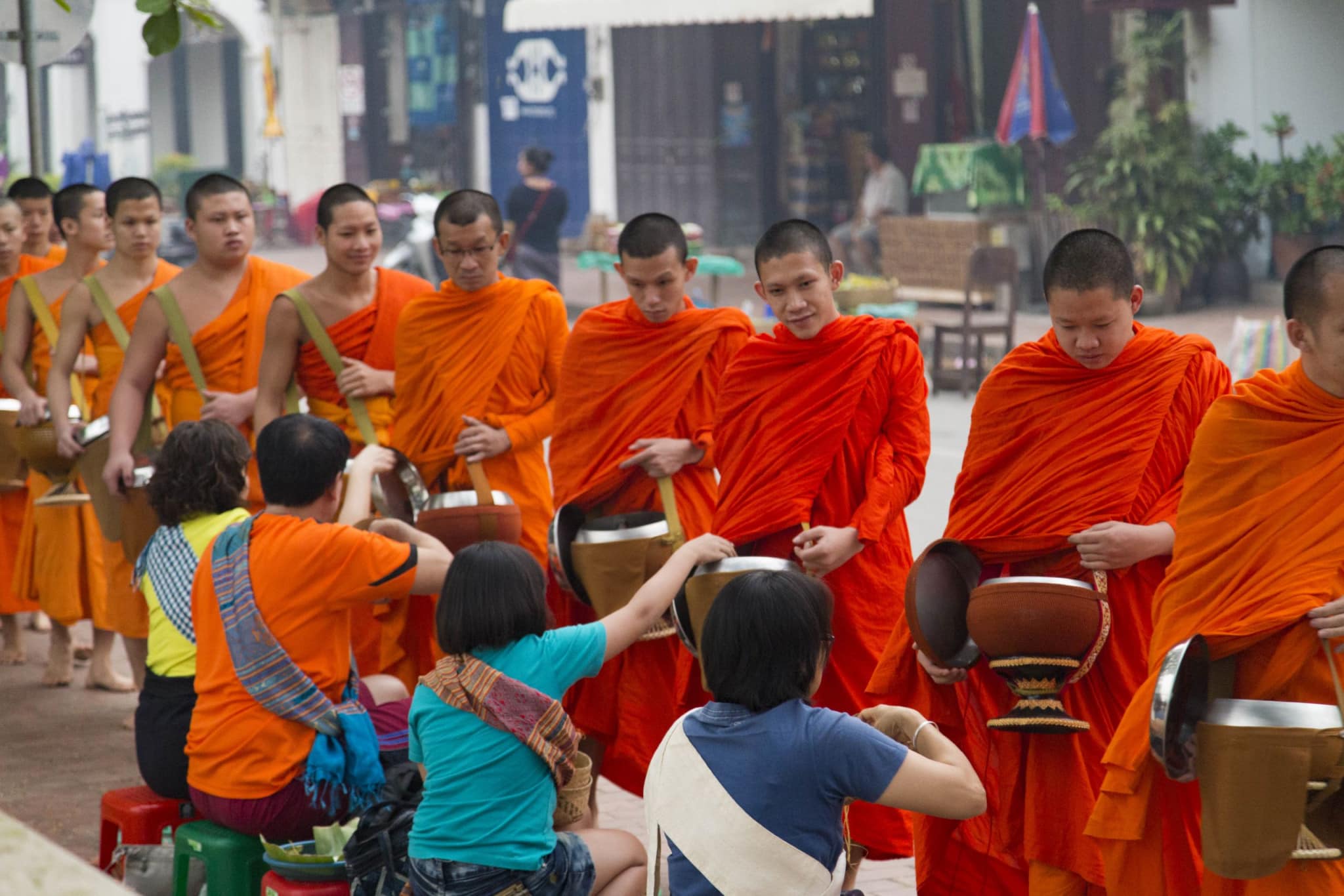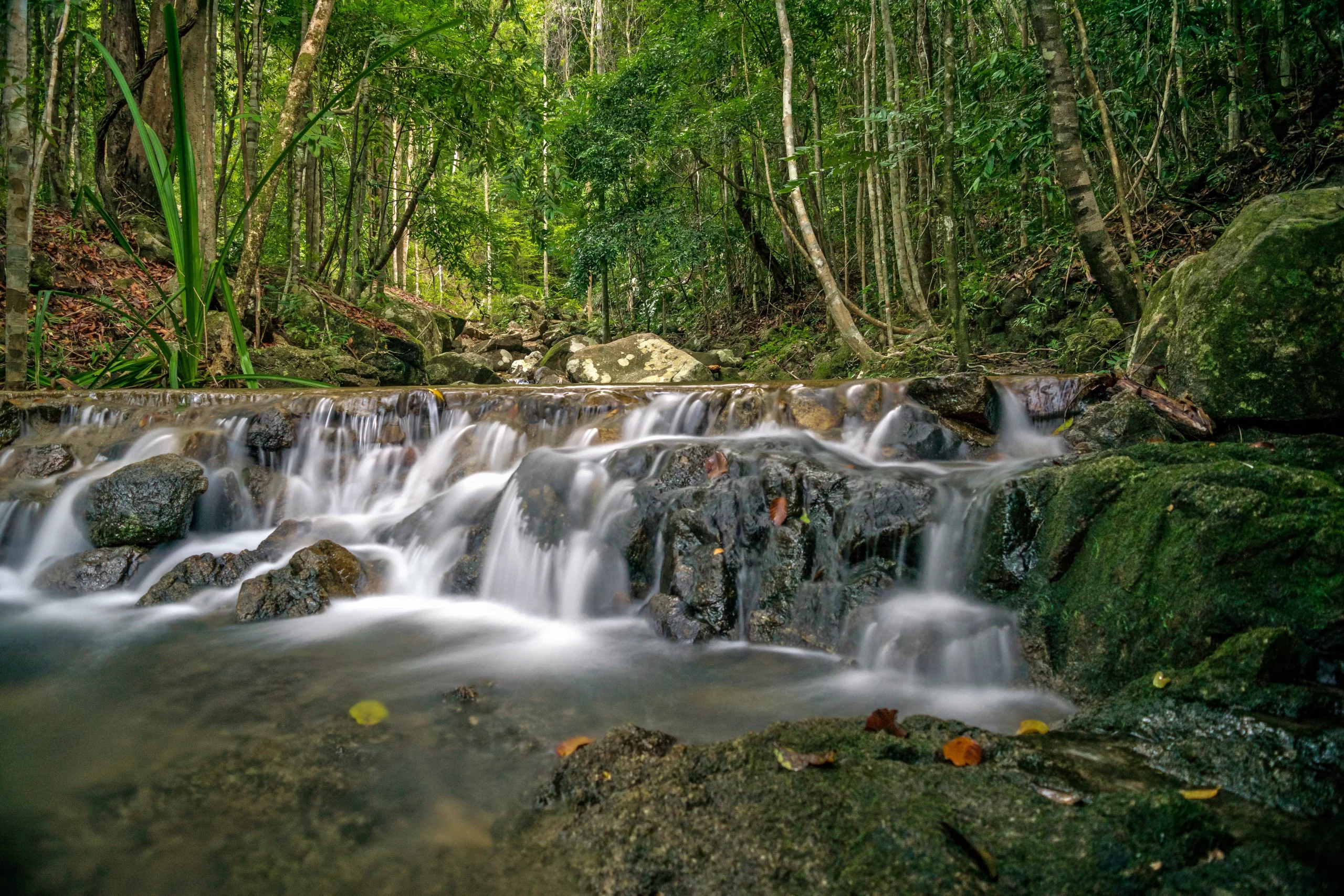1. Top things to do in Vientiane
Attend the unique Alms – giving ceremony (Tak Bat)
Taking Alms Giving Ceremony in the early morning will be one of the most interesting experiences that you can have in Vientiane.
As a nation deeply rooted in Buddhism, Laos boasts numerous pagodas and temples that offer a glimpse into the profound connection between its culture and the religion. One such tradition is the Alms Giving Ceremony, or "Tak Bat," a sacred ritual that unfolds at dawn. It is during this serene time that Buddhist monks emerge from their temples to collect offerings from the local community. Engaging in this ritual promises to be an unforgettable experience during your visit to Vientiane.
To attend the ceremony, you'll need to wake up early, typically around 5:00 AM to 6:00 AM. It's important to dress respectfully and prepare offerings in advance. Then, patiently wait for the procession of monks as they make their way through the streets.
The ritual will be done in silence, respect and Laotians will make a short pray before putting food into the monk’s bowl. Later, these offerings will be shared for themselves, poor people, other monks and animals at the temples. The monks only have one meal per day.

Visit the Morning Market
Make sure to visit the Morning Market, an absolute must for experiencing the vibrant culture and shopping scene of Vientiane, the capital city of Laos. Known as Vientiane Morning Market or "Talat Sao," this bustling marketplace offers an array of souvenirs, handicrafts, and fresh produce that will surely pique your interest.
From traditional handicrafts to exquisite silk fabrics, exotic snake whiskey to sparkling jewelry, the market caters to a wide range of tastes and preferences. Operating daily from 7:00 AM to 4:00 PM, it provides ample opportunities to explore and indulge in local treasures. Whether you prefer navigating the market independently or with the assistance of a knowledgeable local guide, you'll have the chance to haggle for the best deals.
Notably, there is no entrance fee, allowing you to roam freely and soak in the lively atmosphere, complete with the enticing sights and sounds of this dynamic market. Don't pass up this chance to uncover the authentic and diverse products that showcase the rich culture of Laos at the Vientiane Morning Market.

Go on a cycling tour
Biking is one of the best ways to explore the region and discover the hidden places, encounter new cultures and experience the nature on two wheels. This kind of tour becomes more popular today. You can choose half or full day with local guide for touring around the city to villages, temples and markets. You can also cycle along the banks of the scenic Mekong River as another way to check out the city as well as get a workout in at the same time.

Join in a cooking class
Explore the secrets of Laos cuisine by taking a cooking class in Vientiane. Learning how to cook typical cuisine of destination that you travel to is always a great experience. Participating in a traditional cooking class will first lead you to the vibrant local market, where you'll have the opportunity to handpick fresh ingredients and fragrant herbs that will elevate your meal. Guided by a professional chef, you'll then be introduced to the art of preparing a delightful array of dishes. After finishing the dish on your own, it is time for you to sit down and savor the fruits of your labor. If you whip up fancy Lao meals, let’s try to practice and invite your friends to taste when you are back home.

Try local foods & drinks
For the enthusiastic food lover, Vientiane serves as a tantalizing gateway to the world of delectable Laotian cuisine. During your stay in the nation's capital, there's a treasure trove of specialties that beckon your taste buds to explore.
Indulge in the authentic taste of Lao sausage, featuring two main varieties that pair harmoniously with a chilled beer: the savory Sui oua, a flavorful blend of fatty pork and spices, and the distinct Sai krok, which undergoes fermentation for a few days, imparting a delightful sweet and tangy twist. Don't miss the chance to savor sticky rice, crickets, grasshoppers, and other edible insects that add unique crunch and flavor to your culinary adventure.
For those seeking heartier options, the Mekong catfish, Khai Look (fetal duck or chicken egg), Khao piak (rice noodle soup), and the zesty Larb (meat salad) are must-try dishes that showcase the rich tapestry of Laotian flavors.
A bottle of iced cold Beerlao should not be missed here. Other drink types such as fresh fruit, lots of flavors, and soy milk are available too. You can easily dine these specialties at local restaurants or street food stalls around.

Wander at Vientiane Night Market
By 5pm every evening, the riverside night market in Vientiane springs to life, hundreds of red awnings are set up & operation until 10pm. Here, you can find a wide array of goods such as clothes, textiles, accessories, handicrafts, paintings and myriad souvenirs. There is also a playground with swings, monkey bars, slides for children in the middle of the market.
Unlike other night markets, there is no food sold here, but you can find plenty of street food vendors and restaurants around the market.

Go for a massage and herbal sauna
End of your day with a massage and herbal sauna will definitely be great.
Vientiane is renowned for its unique massage techniques that incorporate herbal saunas and steam rooms. In this local practice, indigenous plants and herbs are carefully boiled within the confines of a traditional Laotian bathhouse, creating a soothing, steam-filled sanctuary.
Following this herbal sauna experience, you'll be treated to a relaxing massage, melting away any accumulated stress or fatigue. Such a delightful conclusion to your day ensures a restful night's sleep, leaving you refreshed and eagerly anticipating the adventures of the day ahead.

2. Vientiane Weather
3. Transportation: How to Get to & Around Vientiane
3.1. How to get there?
Getting to Vientiane, the capital city of Laos, typically involves traveling by air or land, depending on your starting point. Here are the most common ways to reach Vientiane:
By Air:
Wattay International Airport (VTE) is the main international gateway to Vientiane. You can book a flight to Vientiane from major cities in Southeast Asia and beyond. Airlines such as Lao Airlines, Thai Airways, Vietnam Airlines, and several others operate regular flights to Vientiane.
By Bus:
If you're already in Laos or in neighboring countries like Thailand, Vietnam, or Cambodia, you can consider traveling to Vientiane by long-distance bus. Bus services are available from cities like Bangkok (Thailand), Hanoi (Vietnam), and Phnom Penh (Cambodia). The journey may take several hours or even overnight.
By Train:
The train network in Laos is limited, but you can take a train from the Thai border town of Nong Khai to Thanaleng Station, which is just outside Vientiane. From there, you can arrange for transportation into the city.
By Boat:
Some travelers opt for a scenic boat ride down the Mekong River to reach Vientiane. You can take a boat from various towns in northern Laos, such as Luang Prabang.
By Car:
If you're traveling from within Laos or nearby countries, you can drive to Vientiane. The road network connects Vientiane to major cities in Laos and neighboring regions.
3.2. Ways to get around the city:
Walking: The city center of Vientiane is relatively compact, and many of the major attractions, restaurants, and shops are within walking distance of each other. Walking is a great way to explore the city's charm up close.
Tuk-Tuks: Tuk-tuks are a popular and convenient mode of transportation in Vientiane. These three-wheeled vehicles can be found throughout the city, and they are a great way to explore the local sights. Make sure to negotiate the fare before starting your journey as tuk-tuk drivers often do not use meters.
Vientiane also has a bus system, however it mostly serves the city’s outskirts, which are unlikely to recommended to tourists















